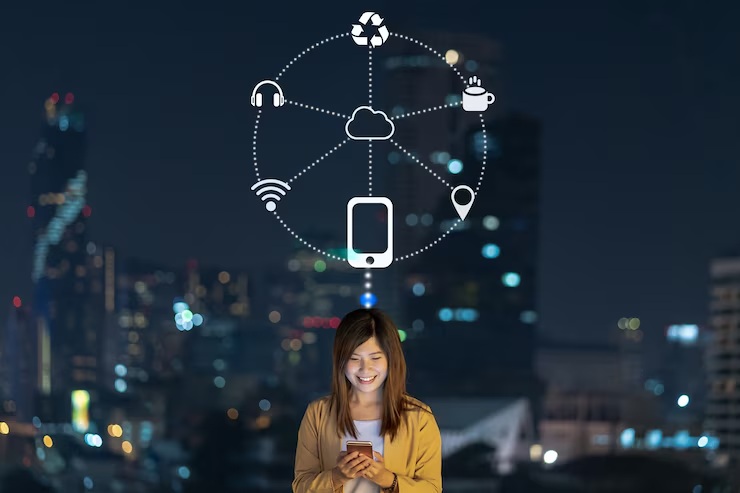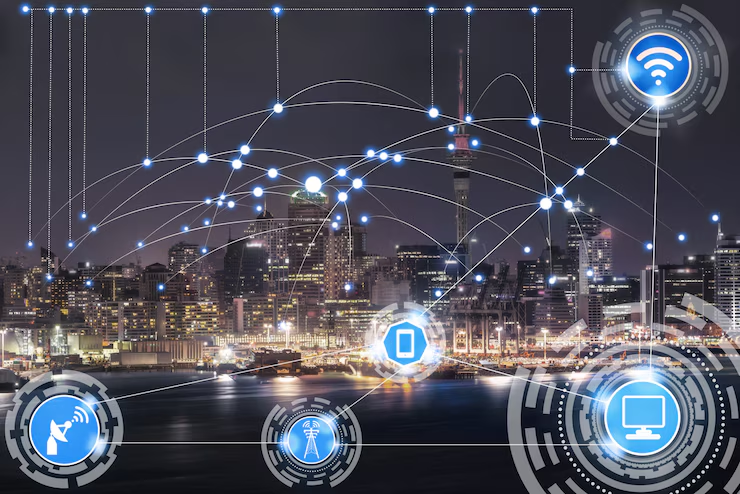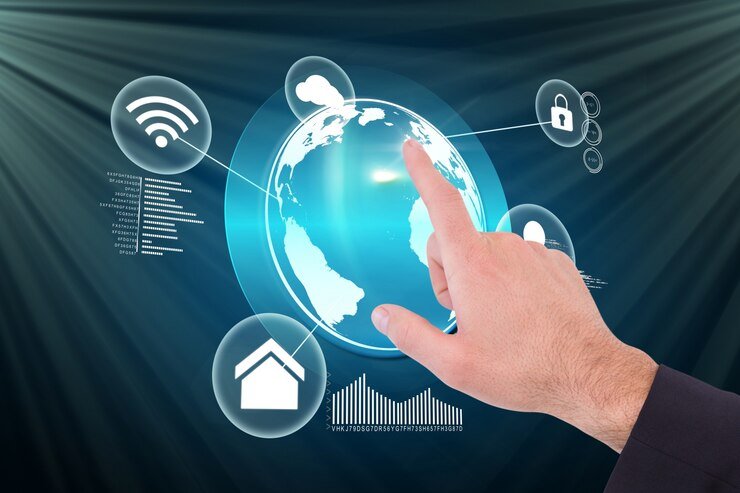The IoT technology in 2024 is changing how we live, work, and interface with advancement. In essential terms, IoT suggests the association of real things contraptions, vehicles, machines, and various articles that are embedded with sensors, programming, and various advances to connect and exchange data with various devices and structures over the web. From savvy homes to modern IoT applications, this interconnected organization is reshaping enterprises, working on day to day existence, and driving advancement in phenomenal ways.
What is the Internet of Things (IoT)?
This makes an immense organization of interconnected gadgets that can convey independently, without human intercession.IoT gadgets can be anything from cell phones and wearables to modern machines and rural sensors. For instance, a shrewd indoor regulator in a home can change the temperature in view of the mortgage holder’s ways of behaving, while an associated vehicle can speak with neighboring vehicles to streamline traffic stream.
How IoT Works
The operations of IoT include a few key parts that cooperate flawlessly:
Devices/Sensors
At the core of IoT are the gadgets or sensors that gather information. These can incorporate anything from movement indicators to ecological sensors, wearables, and, surprisingly, regular family things like coolers or lights. These gadgets continually accumulate data from their current circumstance, like temperature, moistness, development, and that’s just the beginning.
Connectivity
Whenever information is collected, it should be sent to a focal area for handling. IoT gadgets utilize different network techniques like Wi-Fi, Bluetooth, Zigbee, or cell organizations to send this information to the cloud or a neighborhood server.
Data Processing
The information gathered from IoT gadgets is then handled to determine significant bits of knowledge. This can occur in the cloud, where strong information examination apparatuses can be applied, or at the “edge” of the organization, where edge figuring processes information nearer to the gadget for quicker direction.

Action
At long last, in view of the handled information, moves are made. For instance, a savvy indoor regulator could change the temperature of a room, or an associated vehicle could caution the driver of expected risks. These activities are commonly mechanized and don’t need manual intercession.
Improved Efficiency and Automation
One of the main benefits of IoT is the capacity to mechanize processes and further develop proficiency. For example, in assembling, IoT-empowered machines can consequently change their tasks in view of continuous information, lessening personal time and expanding efficiency. Additionally, IoT gadgets in homes, like savvy lights or indoor regulators, can work independently, saving energy and upgrading accommodation.
Better Decision-Making Through Data
IoT gadgets create immense measures of information, which can give significant bits of knowledge to direction. By examining this information, organizations can upgrade their tasks, further develop client encounters, and recognize patterns. For instance, retailers can utilize information from IoT gadgets to follow stock progressively, permitting them to effectively restock well known things more.
Enhanced Safety and Security
IoT is assuming a significant part in upgrading wellbeing and security across different areas. In shrewd homes, IoT gadgets like surveillance cameras, movement sensors, and doorbell cameras give continuous checking and alarms, working on generally speaking security. In businesses like medical services, IoT-empowered wearables can screen essential signs, ready medical services suppliers to possible issues, and even save lives in crises.
Cost Reduction
By empowering better administration of assets, IoT can assist organizations and people with lessening costs. In agribusiness, IoT sensors can screen soil conditions and weather conditions, empowering ranchers to enhance water system plans and lessen water use. Essentially, prescient support empowered by IoT sensors can assist organizations with staying away from expensive hardware disappointments and expand the life expectancy of apparatus.
Smart Homes
One of the most generally perceived utilizations of IoT is in the improvement of savvy homes. Shrewd gadgets like indoor regulators, lights, locks, cameras, and apparatuses can be generally associated and controlled somewhat through cell phones or voice partners. IoT has made homes more energy-proficient, secure, and advantageous, permitting clients to screen and control different parts of their home climate from anyplace.
Agriculture
IoT is changing horticulture by giving ranchers instruments to screen and streamline crop development. IoT gadgets can follow soil dampness levels, atmospheric conditions, and irritation action, assisting ranchers with coming to information driven conclusions about water system, treatment, and nuisance control. This prompts more manageable cultivating rehearses and expanded crop yields.
Transportation
IoT is likewise changing the transportation business. Associated vehicles can speak with one another and with foundation, further developing traffic stream and decreasing mishaps. IoT is likewise utilized in armada the board to follow vehicles continuously, screen driver conduct, and improve courses. In strategies, IoT sensors are utilized to follow shipments and guarantee that products are followed through on time and in ideal condition.
Industrial IoT (IIoT)
The Modern Web of Things (IIoT) alludes to the utilization of IoT in modern settings, like assembling, mining, and oil and gas. IIoT empowers machines and gear to gather information, speak with one another, and settle on continuous choices that further develop efficiency, diminish waste, and upgrade laborer security. Prescient support, for example, utilizes IoT sensors to distinguish likely disappointments in apparatus before they occur, forestalling expensive margin time and fixes.
Challenges of IoT Adoption
While IoT holds monstrous potential, its reception isn’t without challenges.
Security and Privacy Concerns
As IoT gadgets gather and send huge measures of individual and touchy information, guaranteeing the security and protection of this data is basic. Network safety dangers, for example, hacking and information breaks, present huge dangers to IoT frameworks. To alleviate these dangers, IoT gadgets should be furnished with powerful encryption, secure confirmation, and ordinary programming refreshes.

Interoperability
With the tremendous number of IoT gadgets accessible on the lookout, guaranteeing interoperability between changed gadgets and stages is another test. Numerous IoT gadgets utilize different correspondence conventions and guidelines, which can make it hard to incorporate them into a durable environment. Industry guidelines and structures are fundamental to conquer this test.
Data Management
The sheer volume of information produced by IoT gadgets can overpower conventional information stockpiling and handling frameworks. Associations should foster procedures for making due, dissecting, and putting away this information productively. Utilizing distributed computing and edge processing can assist with tending to information the board difficulties by giving adaptable and decentralized arrangements.
Power Consumption
Numerous IoT gadgets, particularly those in remote or outside settings, depend on battery power. Guaranteeing that these gadgets have adequate battery duration while keeping up with superior execution is a key concern. Low-power IoT innovations and energy-effective plans are essential to the proceeded with development of IoT applications.
The Future of IoT
The Web of Things is supposed to develop, with progressions in man-made consciousness (artificial intelligence), AI (ML), and 5G network assuming a huge part. The reconciliation of man-made intelligence and ML will empower IoT gadgets to become more brilliant and more independent, equipped for pursuing choices without human intercession. With the rollout of 5G organizations Future of Internet of Things gadgets will actually want to communicate information quicker and all the more dependably, opening additional opportunities for constant applications.
As IoT keeps on developing, it will additionally penetrate each part of our lives, making more astute urban areas, more effective ventures, and more associated networks. The potential for advancement is boundless, and the fate of IoT is one where everything — from homes and vehicles to processing plants and ranches — is interconnected and insightful.
IoT’s Role in Sustainability and Environmental Conservation
The Web of Things (IoT) is progressively being perceived for supporting manageability endeavors and ecological conservation potential. By giving constant information on energy utilization, squander age, and asset use, IoT assists associations and people with making more intelligent, more eco-accommodating decisions. For example, shrewd lattices fueled by IoT sensors can improve the dispersion of power, diminishing energy wastage and empowering better incorporation of sustainable power sources. In horticulture, IoT gadgets that screen soil dampness, weather patterns, and yield wellbeing assist ranchers with utilizing water and manures all the more productively, limiting natural effect. As the worldwide spotlight on supportability develops, IoT will keep on assuming a pivotal part in assisting enterprises with diminishing their carbon impression and carry out greener practices.
The Economic Impact of IoT on Global Markets
The financial effect of IoT is tremendous, with the innovation driving development across different areas. As per industry conjectures, the worldwide IoT market is supposed to arrive at trillions of dollars in esteem over the course of the following 10 years, setting out new open doors for organizations and legislatures the same. IoT has previously prompted the making of new plans of action, for example, the ascent of membership based administrations for brilliant home gadgets or prescient upkeep answers for assembling. As IoT reception keeps on developing, the innovation will drive expanded efficiency, lessen functional expenses, and empower more successful asset designation across enterprises. This monetary shift will make occupations in IoT advancement, information examination, and network safety while at the same time changing existing business sectors by cultivating development and contest.
Conclusion
The Web of Things is without a doubt a distinct advantage that is molding our associated future. From improving comfort and productivity in our day to day routines to changing businesses like medical care, horticulture, and assembling, IoT is setting out new open doors and driving advancement. While difficulties like security, interoperability, and information the executives stay, the eventual fate of IoT holds colossal commitment. As IoT keeps on developing, it will open additional opportunities, making a more associated, productive, and maintainable world for a long time into the future.
